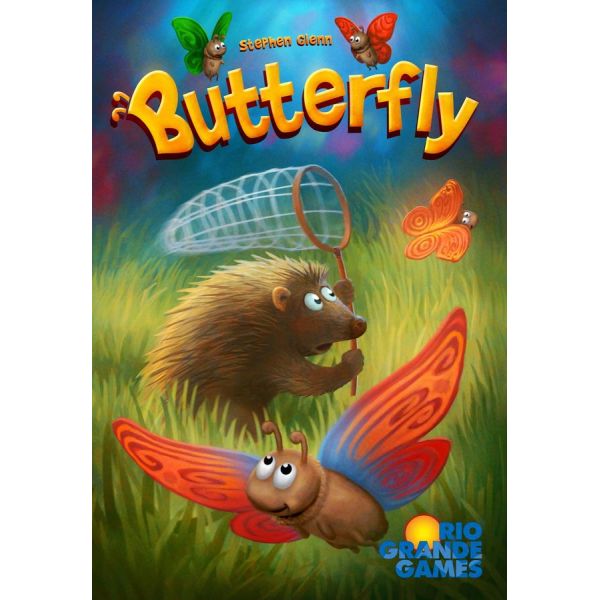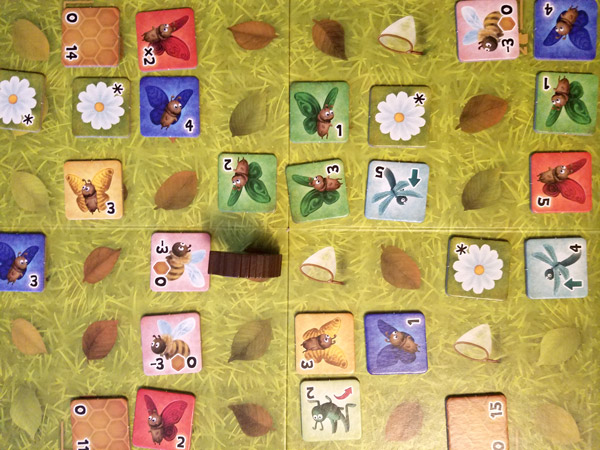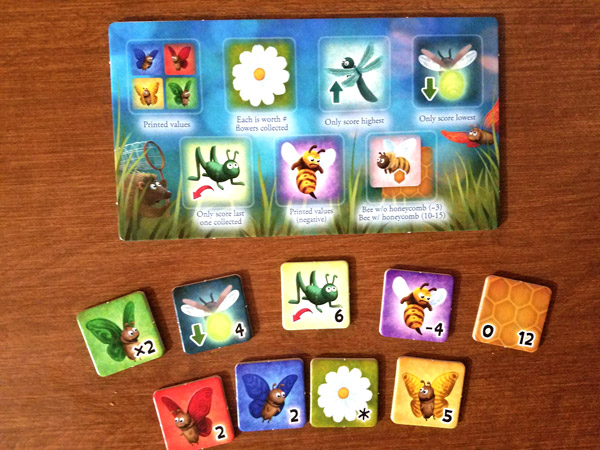Catch the Best Collection of Insects in Butterfly

Butterfly is a new abstract strategy game from Spiel des Jahres nominee Stephen Glenn. Designed for 2 to 5 players, this game asks players to maximize their movements across a variably-sized grid.
Gameplay
Play begins with setting up the board based on player count and drawing the subsequent amount of tiles from the bag to populate the required area. There are 100 tiles in the game, which include butterflies, bees, honeycombs, grasshoppers, dragonflies, flowers, and wasps. Players take turns moving a hedgehog across the board to another tile within the same row or column. Players then pick up the tile and add it to their collection. Players may not stop on any empty spaces at any time.

Each tile is worth a printed point value, but each scores differently depending on the situation and what tiles have been collected. Butterflies score by the printed value on each tile no matter their color, though some butterflies will offer a bonus of doubling the total points for a specific color. Bees are worth points when paired with honeycomb tiles, but bees without honeycombs will subtract three points per unmatched tile in the final score. Likewise, honeycombs only score when paired with a bee tile — otherwise, they are worth zero points. Grasshoppers and Dragonflies reward points based on the highest and lowest score on the last tile a player collects of that type at game’s end. Flowers score depending on how many flowers a player has collected. For example, if a player has two flowers at the end of the game, they will score two points per flower. Finally, wasps are worth negative points.
Tiles may also be gained by passing over butterfly nets that are exposed as tiles and are accrued over the course of a game. When a player passes over a butterfly net in a row or column, they can decide to reach into the bag and blindly pull out a tile, accepting the points or penalties it offers.
The game ends when a player is unable to move in a row or column and collect a tile. Points are tallied according to the point totals printed on tiles and their scoring conditions, with the highest point total winning the game.

Review
Despite its cartoonish art style and childlike appeal, Butterfly is a great introduction to abstract strategy games that also offers some depth for more experienced gamers as well. With over 100 tiles in the base game, each game will offer different scoring scenarios, board layouts, and scoring opportunities. As simple as the movement of the hedgehog is, it becomes quickly noticeable that movement is more restrictive than it first appears.
How tiles score at the end of the game also provides its own puzzle. Grasshoppers and dragonflies offer appealing point totals, but a miscalculation in the timing of collecting it — or being forced to take one that offers fewer end game points when it was unexpected — requires players to plan out moves as best they can. Of course, in a game when players are strategizing their own moves and wants, having backup plans and exit strategies to change which row or column is being farmed is key. Likewise, butterfly nets may allow players to find a bit of luck in a blindly drawn tile but it can also cost someone just enough points if a wasp or a bee that cannot be paired with a honeycomb is drawn.
The only negative are flowers, which can provide beaucoup points for one or two players if others neglect to collect them. In this way, flowers also fail because after one playthrough, no one is going to allow another player to collect too many flowers without doing so themselves. In the end, these make flowers either overpowered or awash at the end of the game.
Yet, all of this leads to great player interaction without incorporating negative consequences forced on one player by others. It’s nearly impossible to be a player on an island in Butterfly, as one's movements are going to directly and indirectly affect the future movements of others.
Don’t be fooled by its cute art style. Butterfly offers some deep thinking and strategic options that are far from cuddly. But its 15-20 minutes playtime will mean players keep returning to try to improve their scores and sharpen their abstract thinking skills.
Pros: Quick gameplay with thinky abstract elements, scoring and playthrough variability, solid player interaction
Cons: Flower tiles can be overpowered or worthless




